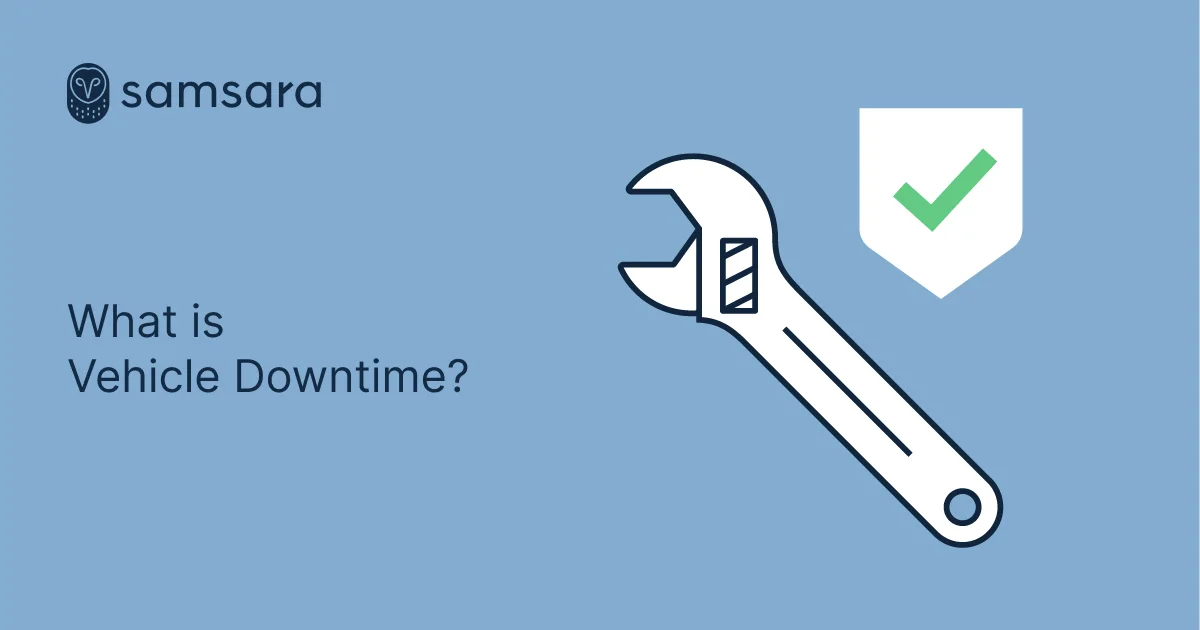What is Vehicle Downtime?
October 22, 2021

Get Started With Samsara
Check Our PricesKey Takeaways
In the fleet world, vehicle downtime—especially unplanned downtime—oftens translates into a loss of income because the vehicle is not productive. While some reasons for downtime can’t be controlled, fleet managers can take steps to minimize unplanned downtime. Learn more about what causes downtime and how to prevent it.
What is vehicle downtime?
Vehicle downtime refers to the period of time when a vehicle is unavailable. This unavailability can be caused by various factors, including planned or unplanned maintenance, repairs, accidents, or driver/vehicle violations.
The opposite of vehicle downtime is uptime, or when a vehicle is in good standing and operational.
What is planned downtime vs. unplanned downtime?
Planned downtime (also known as scheduled downtime) is when you schedule a vehicle’s unavailability at the company’s convenience. It minimizes disruption to fleet operations and allows for preventive maintenance. Having a proactive maintenance program, complete with regular maintenance schedules, helps organizations reduce unexpected repair costs and extend a vehicle’s lifecycle.
Conversely, unplanned downtime (also called unscheduled downtime) is a lapse in operations. It happens unscheduled, outside your control, and rarely happens at a convenient time. Unplanned fleet downtime can be costly, with emergency repairs eating into a business’s bottom line. It also can take longer to get services up and running again, costing businesses valuable time and reputation.
Common causes of vehicle downtime
Many factors can lead to vehicle downtime. Here are the most common issues:
Mechanical problems
Mechanical problems are a common source of downtime for fleets as parts get worn quickly from natural wear and tear and driving styles. Without regular vehicle maintenance, a minor problem can turn into a costly larger problem in the future.
Accidents
Fleet vehicles that get involved in accidents can cause significant unplanned downtime. While some accidents are unavoidable because other drivers cause them, they affect the business just the same.
Vehicle violations
Some downtime results from administrative reasons. Without proper fleet management, vehicles may violate regulations, forcing the vehicle out of service. Violations can include anything from expired tags to having registration renewals denied due to unpaid fines.
Driver violations
A driver who is not in compliance with regulation can also suddenly be taken out of service. For instance, violating hours of service rules or falsifying logs. If a driver is placed out of service, the fleet manager needs to figure out how to reduce the resulting downtime.
Car towed or booted
Not only do booted and towed vehicles result in downtime, but companies also need to pay the fines and towing expenses associated with the violation.
Emergency repair
These issues don’t always require a trip to the mechanic but result in downtime nevertheless. For example, truckers getting locked out of the cab, running out of fuel, or encountering a dead battery.
Weather
While many of the downtime causes are preventable, inclement weather is not. Severe rain, snow, hail, and natural disasters can curtail careful routing.
Recalls
Recalls are a headache for fleet operations. It leads to unplanned downtime while the vehicle gets repaired. If the vehicle goes unrepaired, it could lead to an even longer and costlier trip to the shop.
Preventing vehicle downtime
There are several preventative maintenance steps businesses can take to reduce downtime.
1. Invest in fleet management software.
Fleet management software can help you make more informed maintenance decisions based on real-time data from a telematics device. With electronic DVIRs and fault code alerts, you can be immediately notified of any vehicle maintenance issues—including issues with a fuel system, exhaust system, fluid leaks, transmission fluid, engine oil, and more.
2. Start a preventive maintenance program
A preventive maintenance program ensures regular maintenance tasks are completed. When your commercial vehicles have regular servicing, you’re less likely to have unplanned downtime and fleet costs go down because vehicles have a longer lifespan.
3. Plan for vehicle replacements
While regular fleet maintenance prolongs the lifespan of vehicles and optimizes their performance, nothing lasts forever. Eventually, vehicles kept past their lifecycle will become less efficient while incurring more maintenance costs. Having a replacement plan in place ensures you replace older vehicles before they experience costly breakdowns.